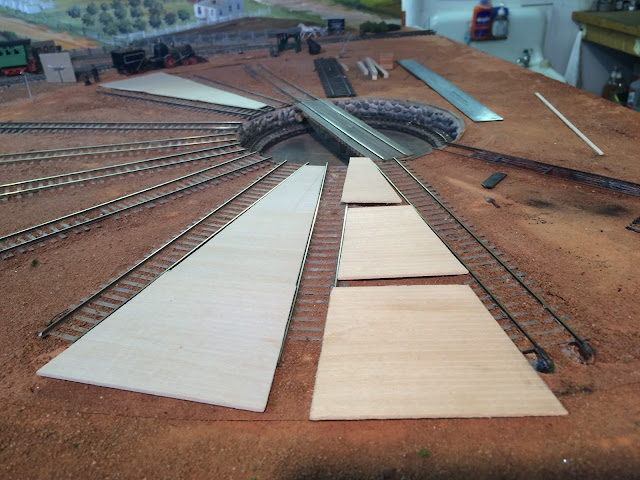DETAILS
We are near the end of the line, Chattanooga, regarding completing structures and basic scenicing. Although there is one nasty electrical issue haunting the Kingston area, we are switching to adding details to a moderately detailed model railroad. This includes everything from more figures and lighting to structural detailing and scenic elements at Kennesaw. We have also begun conversations for operations. My big to-do is adding more locos! More on locos and operations in the near future.
One obvious detail in waiting was a spout for a water tank built many years ago. Although a spout can be purchased I thought I'd try carving one from balsa as I wanted to get this project done asap.
Using the tank built by a very good scratch builder Chris Comport, http://chriscomport.com, as a reference, it was quite easy to fashion a spout. I took a block of scrap balsa and drew the spout profile. Making a few cuts to remove excess wood, it was then a matter of fine sanding, comparing, sanding and comparing, many times over until it looked about right.
Next was to build the spout's supporting frame which I also modeled from Chris' design. Although I combed the web for images and found some cool examples, this activity was after I began mimicking Chris' tank. I continue to remind myself of my impatience!! However, I wanted the spout configurations looking more similar than not for continuity. In the end it worked out reasonably well.
The one difference between Chris' model, foreground, and mine is that his is wood, the other is styrene. Originally I painted it grayish colors. It was my attempt to fashion weathered wood; and it looked just like that... an attempt. This photo shows it after it was scored and carved with a #11 and a wire brush. Mixing burnt sienna and tan colors, some yellow ochre and a touch of black brought it closure to this look which has a more wood-like appearance, to me at least.
The weights and channels I believe are iron made; hence the colors chosen were intended to look like weathered iron. The 't' frame holding the channels appeared to be wood and were painted as such. All parts however are styrene.
Here is the styrene tank with all her parts, ready to be assembled. Details West brass wire has been inserted into pre-drilled holes and glued with Loctite (a super glue). The wire attached to the weights will receive chain end links. The wire is small enough receive the tiny link which is then glued in place. Once dry the wire is trimmed down to the link. Same for the wire extending from the top beam. A link will be attached to it. I did this to ensure reasonable tension and a consistent look between the two, vs having the chain drooping... very untidy that way.
The spout also has a brass ring where the chain is attached from the weights. Wire is same size and simply wrapped once around the spout then twisted with needle nose leaving the tiniest end for the link.
The finished product...















































